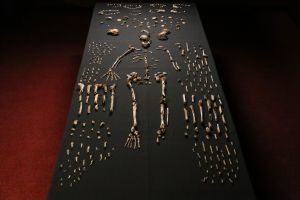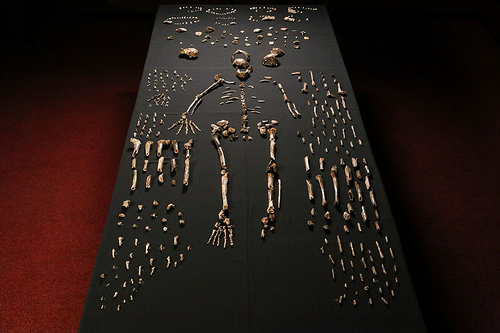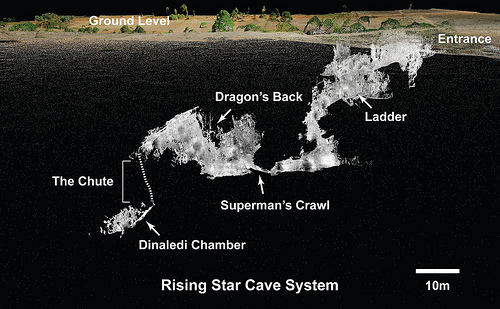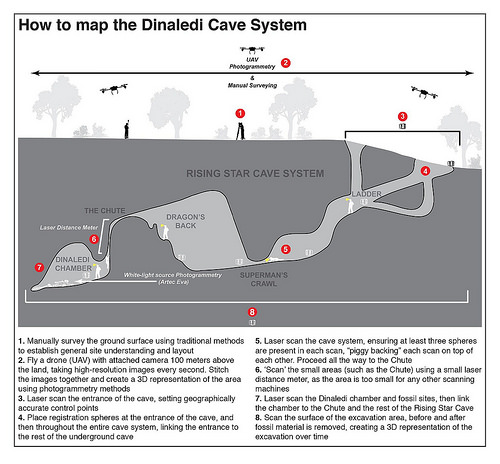
In 2013, after the discovery of an unprecedented hominin assemblage in South Africa, the University of the Witwatersrand’s (Wits) Professor Lee Berger extended a worldwide call for “skinny” explorers to join him on the expedition to excavate what became known as the Dinaledi Chamber, located within a cave system known as Rising Star near the Sterkfontein Caves, about 40km North West of Johannesburg. An all-female team of six “underground astronauts” were selected to undertake the underground excavation, due to the challenge of navigating a 12-meter vertical chute and passing through an 18-centimeter gap. Over 1500 fossils were found, representing a new species designated by the examining scientists as Homo naledi.
Berger himself was unable to go down into the chamber, and the extremely difficult conditions in which Berger’s Rising Star team was forced to work thus gave rise to the use of space-age technology to bring the high resolution digital images to Berger and team members on an almost real-time basis in order to make vital decisions regarding the underground excavations. Ashley Kruger, a PhD candidate in Palaeoanthropology at the Evolutionary Studies Institute at Wits, who was part of Berger’s initial Rising Star Expedition team, roped in the use of high-tech laser scanning, photogrammetry and 3D mapping technology to make this possible.
_________________________________________
The fossils of Homo naledi. Courtesy John Hawks, Wits University
______________________________________________________
“This is the first time ever, where multiple digital data imaging collection has been used on such a sale, during a hominin excavation,” says Kruger.
Kruger and colleagues have now mapped the entire path of the Rising Star Cave, including the Dinaledi Chamber, both on the surface and underground, using a combination of aerial drone photography, high-resolution 3D laser scanning, a technique called white-light source photogrammetry, and conventional surveying techniques. The research paper, Multimodal spatial mapping and visualisation of Dinaledi Chamber and Rising Star Cave was published in the scientific journal, the South African Journal of Science, on Friday (see link to the paper below).
“The 3D scans of the cave and excavation area helped scientists above ground immensely in making decisions about the next step to take with regards to excavations,” says Dr. Marina Elliot, Rising Star excavation manager, and co-author of the paper.
“These methods provided researchers with a digital representation of the site from landscape level right down to individual bones,” says Kruger.
____________________________________________
A scaled graphical representation of the Dinaledi cave system using 3D scanning. Courtesy Wits University
_________________________________________________________
Dinaledi infographic: How to map the Rising Star Cave system. Courtesy Wits University
_____________________________________________________________
The precise digital reconstruction of the Rising Star Cave provides new insights into the Dinaledi Chamber’s structure and location, as well as the exact location of the fossil site. It also paints a detailed picture of the challenges that the underground astronauts had to deal with in navigating the caves on a daily basis for over five weeks in November 2013 and March 2014.
“We realise now, through the use of high-resolution scanning that the Dinaledi chamber is about 10 meters deeper than we originally thought,” says Kruger. This is important in understanding the processes which may have aided the site’s formation.
Kruger’s paper is the first of a number of papers due to be published on the spatial understanding of the Homo naledi site within the Dinaledi chamber. The rest of his research aims to provide answers about how the site formed, what the position of the fossils can tell researchers, as well as to paint a more detailed picture on how the hominin bodies came to be in the cave.
(See the video below for more information.)
Source: Adapted and edited from the Wits University subject news release.
The published paper can be accessed here.
______________________________________________________
___________________________________________________________

______________________________________________
Travel and learn with Far Horizons.
____________________________________________
This richly illustrated issue includes the following stories: Recent findings shedding new light on the whereabouts of the remains of Philip of Macedon, father of Alexander the Great; how an archaeologist-sculptor is bringing bones of the dead back to life; archaeologists uncovering town life at the dawn of civilization; an exclusive interview with internationally acclaimed archaeologist James M. Adovasio about what makes the Meadowcroft Rockshelter prominent in the ongoing search for the first Americans; what archaeologists are finding at the site of the ancient city of Gath, the home town of the biblical Philistine giant, Goliath; and how scientists are redrawing the picture of human evolution in Europe. Find it on Amazon.com.











